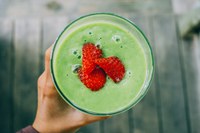Prairie Fare: Are You Eating Your Vegetables?
(Click an image below to view a high-resolution image that can be downloaded)
By Julie Garden-Robinson, Food and Nutrition Specialist
NDSU Extension
“All we do is eat, nap and play,” the young gentleman said to my nutrition intern.
I almost burst out laughing at the 5-year-old’s comment. That sounds like a nice time to me.
My intern was trying to move him along to the next activity. He was slowly sipping the smoothie he helped make.
“I want to have this every day!” another young gentleman remarked.
“Why is it green?” he asked.
“Do you remember what green vegetable we added?” I prompted.
“Spinach!” he noted.
We had fun delivering a “live” nutrition lesson to a group of preschoolers. They learned about fruits, vegetables and where their food comes from as they interacted with a story and a game.
They enjoyed taste testing the most, I think. I had suggested the “Green Monster Smoothie” recipe, but I wasn’t sure whether they would drink the fruit and veggie-packed beverage.
All the green mustaches on their upper lips convinced me that they liked it.
Green vegetables are among the foods lacking in the diets of all Americans, regardless of age.
Recently the 2020 to 2025 Dietary Guidelines were released to help guide nutrition education. These guidelines recommend that Americans include a variety of vegetables from all the vegetable subgroups. The subgroups are dark green, red and orange, starchy and legumes (beans, peas and lentils).
We also need to eat more whole fruit and foods from all the other food groups, including meat, dairy and grains.
Do these messages sound familiar? The new guidelines are fairly similar to the last five-year edition, but they include new recommendations for infants and toddlers, expanded recommendations for pregnant or breastfeeding women and updated recommendations for children, teens, adults and older adults.
Basically, the new guidelines include updates for all of us.
Let’s talk about spinach, which lends its brilliant hue to our recipe of the week. Spinach and other dark green leafy vegetables provide a range of nutrients. Spinach is one of the best foods to promote eye health. Lutein and zeaxanthin, the natural pigments in spinach, may help protect us from macular degeneration, a leading cause of blindness.
Depending on your age, you might remember Popeye the Sailor Man gulping down cans of spinach. His arm muscles bulged almost as soon as he ate his spinach.
I can’t promise large biceps without a lot of weight lifting and good nutrition. However, spinach has a lot of potential health benefits.
Spinach provides us with carotenoid pigments, which our body can convert to vitamin A. That’s good for maintaining healthy skin and mucous membranes.
Spinach is rich in vitamin K, which is essential for blood clotting. However, if you are on certain blood-thinning medications, you will need to follow the advice of a health-care provider about how much you can consume. Vitamin K and some medications can interact.
Spinach contains folate, the natural form of folic acid. Adequate folate and folic acid can help prevent neural tube birth defects, so it is especially important for women before and during pregnancy. We also need this vitamin to build cells throughout the body, including red blood cells.
Spinach is a good source of iron, which is part of hemoglobin in blood. It helps carry oxygen throughout your body.
Along with iron, spinach also provides the bone-building mineral calcium. Calcium is needed for nerve transmission and muscle contraction.
You can have a green “milk mustache” with this week’s nutrition-packed recipe. Don’t worry. It also includes strawberries (rich in vitamin C), banana (rich in potassium), milk and yogurt.
Milk provides potassium, along with numerous other nutrients, and is fortified with vitamin D. The new Nutrition Facts labels now list vitamin D.
Kids tend to be “neophobic” (afraid of new foods). If preschoolers loved this recipe, you might, too.
Green Monster Smoothie
1 1/2 c. strawberries, hulled
2 c. spinach
1/2 banana, peeled
1 Tbsp. orange juice concentrate
1/2 single serving low-fat yogurt, any flavor
1/4 to 1/2 cup milk, water or juice
Place prepared ingredients in freezer-safe bag. Push out air and lay flat in freezer. When ready to prepare, place ingredients in blender with 1/4 to 1/2 cup milk, water or juice.
Makes two servings. Each serving has 160 calories, 2 grams (g) fat, 6 g protein, 32 g carbohydrate, 4 g fiber and 95 milligrams sodium.
(Julie Garden-Robinson, Ph.D., R.D., L.R.D., is a North Dakota State University Extension food and nutrition specialist and professor in the Department of Health, Nutrition and Exercise Sciences. Follow her on Twitter @jgardenrobinson)
NDSU Agriculture Communication - Feb. 4, 2021
Source: Julie Garden-Robinson, 701-231-7187, julie.garden-robinson@ndsu.edu
Editor: Ellen Crawford, 701-231-5391, ellen.crawford@ndsu.edu




